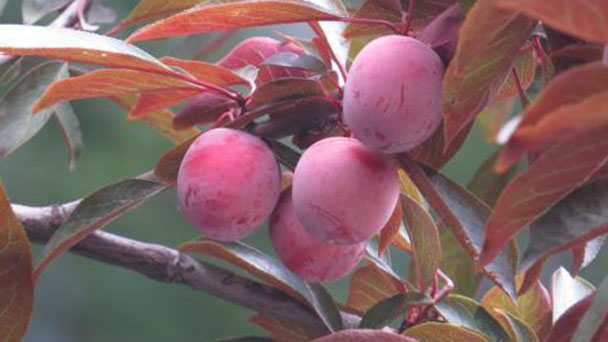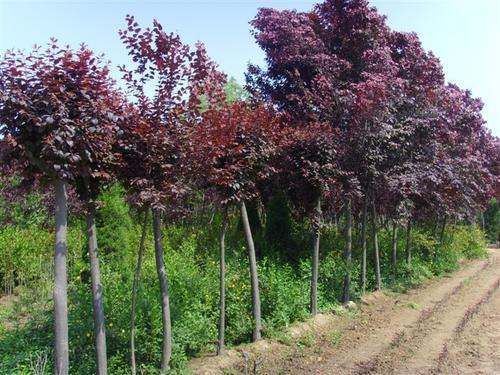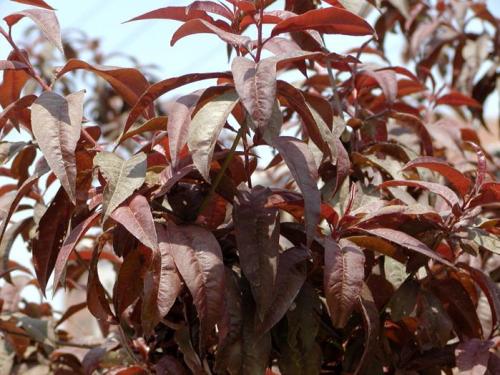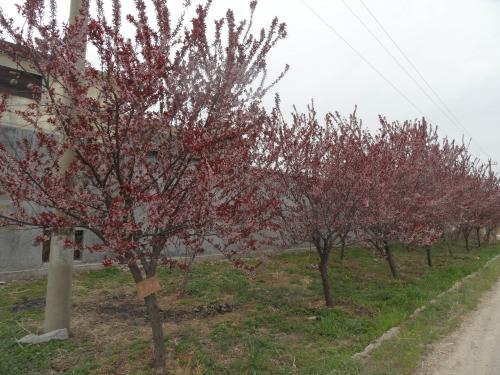How to grow and care for Prunus Cerasifera
Written by Maggie
Jan 08 2021

Prunus Cerasifera is a famous leafy tree whose leaves are perennial purplish red and which, among the green leaves, look like endless flowers. So how to grow Prunus Cerasifera? How to care for Prunus Cerasifera when growing? Let's go and have a look!

How to grow Prunus Cerasifera
Best growing time: Prunus Cerasifera cutting time from late November to mid-December; Bud grafting was carried out in mid-to-late June; Layering operation is carried out from mid-April to mid-May in spring.
Best growing soil: Prunus Cerasifera is highly adaptable to soil, resistant to drought, and more resistant to water and humidity, but grows well in fertile, deep, well-drained clayey neutral and acidic soil, and is not alkali resistant. Gravel soil is good, clay soil can also grow, the root system is shallow, the initiation is strong.
Growth humidity requirement: Prunus Cerasifera likes a slightly wet to dry climate environment, and the optimal growth humidity is maintained at 75 ~ 85 {bf}. Sprays can be used to maintain humidity. The higher the temperature is on sunny days, the more times the sprays are used, and the lower the temperature is on cloudy and rainy days, the less or no sprays are used.
Optimal growth temperature: the optimal growth temperature of Prunus Cerasifera was 15 ~ 30℃, and the optimal rooting temperature of panicle was 20 ~ 30℃.
Best growing light: Prunus Cerasifera likes sunny environments and is slightly shade tolerant, cold resistant and adaptable.

How to care for Prunus Cerasifera:
Fertilizer application:
Prunus Cerasifera likes fertilizer. In addition to a proper amount of fermented fertilizer, Prunus Cerasifera can be applied at the bottom of the pit during planting. In the future, some farmyard fertilizer can be applied every year before pouring frozen water, which can make plants grow vigorously and leaves bright. It should be noted here that although Prunus Cerasifera likes fertilizer, it only needs to be fertilized once a year at the end of autumn, and it should be in an appropriate amount. If too many times of fertilization or too much fertilizer is applied, it will make the leaf dark but not bright, reducing the ornamental value.
Watering points:
Prunus Cerasifera likes a wet environment. In addition to being watered three times, newly-planted saplings should be watered once or twice each in April, May, June and September. July, August rainfall is abundant, if not too dry, can not water, more rain, also should be timely drainage, preventing water rot roots. In early November, the water should be fully watered and thoroughly frozen. Watering should also be done in early March, April, May, June September and early mid-November in the second year of management. From the third year, we only need to irrigate the thawed water and frozen water in early spring and early winter. Water should be controlled in autumn, because the water will cause the branches to grow, and suffer from freezing damage in winter.
Main points of pruning:
After the plant enters dormancy or half dormant period in winter, want thin and emaciated, disease insect, withered, too close wait for branch to cut off.
Replacement of basin-soil:
Transfer basin: as long as the maintenance method, it will grow very fast, when the growth to a certain size (about two to three years), you should consider to give it a bigger pot, in order to let it continue to flourish. One of the following may be used for the culture soil and composition of the pot: garden soil: slag =3:1; Or garden soil: medium coarse river sand: sawdust (shavings) =4:1:2; Or paddy soil, pond mud, one of the leaf rot soil.
Basin: take the pot of flowers on the ground, you want to change with slap dab around the basin, first make the root trembled and separated from basin wall, flower pot upside down on the left hand, left hand index finger and middle finger gently clamp plant, wrist and finger tip to resist basin along the right hand slapping your pelvic floor, then use your thumb from the top down, bottom hole take root soil to plants come out. After taking it out, gently pat the soil in the basin with your palms to remove excess soil.
Pot preparation: choose a suitable size of pot, pot bottom hole with two tiles or thin foam sheet covered, not only to ensure that the basin soil is not washed out, but also to let the excess water flow out in time. A layer of ceramic or broken red brick is placed on the tile or foam as a water filtration layer, about 2 ~ 3 cm thick. Drain layer put fertilizer machine fertilizer, about 1 ~ 3 cm thick, fertilizer on a thin layer of substrate, about 2 cm thick, to separate the root system and fertilizer, finally put the plants in, fill the nutrient soil, leaving about 2 ~ 3 cm from the mouth can.

Propagating points of Prunus Cerasifera:
1. Cuttage propagation
The cuttings are prepared to choose a tree that is 3 to 4 years old and robust as the mother tree.In late autumn after the fallen leaves from the mother tree pruning of the year without disease and insect pests, but also combined with plastic pruning will be cut off the thick, full bud, no disease and insect damage and mechanical damage of the branches as cuttings. Cut the selected cuttings into 40 to 50 cm segments, bundle them with 100 to 200 sticks, and bury them in storage with wet sand.
Cutting time from late November to mid-December. First will just cut off or stored in wet sand branches, cut off the thin branch and water loss dry shrinkage part, and then from bottom to top, long branches cut growth of 10 to 12 cm, 3 to 5 buds. The lower end of the cuttings is cut into smooth inclined planes near the buds to increase the contact surface between cambium and soil, which is conducive to rooting. Cut the top end of the cuttings into a plane 0.8 to 1 cm from the eye. After cutting the cuttings, the lower inclined surface should be immersed in clear water for 15 to 20 hours immediately to make the cuttings fully absorb water.50×10-6ABT6 root powder was used to prepare the rooting agent in proportion and dipped into the cuttings to facilitate rooting. The slope of the cuttings is inserted into the soil downward, with 5×5 cm rows apart and 0.5 to 1 cm buds at the top. After cutting, sprinkle water and irrigation immediately, so that the cuttings and soil close contact. After waiting for the ground to be a little dry with double layer plastic mulch to cover moisture, at the same time on the ridge with 1 meter high and the width of the plastic small arch hut in order to heat preservation, keep out the cold.
2. Bud grafting
Prunus Cerasifera can be seedlings of peach, plum, plum, apricot, mountain peach, mountain apricot, hairy peach and purple leaf plum. Comparatively speaking, peach anvil grows well with purple and green leaves, but it is afraid of waterlogging. As Prunus Cerasifera is more waterlogged resistant. Prunus Cerasifera life is longer, but also afraid of waterlogging. Apricot, peach are commonly used as Prunus Cerasifera in North China.
Prunus Cerasifera generally choose two years of seedlings, it is best to do specialized rootstock culture, before grafting to first short, only to retain the ground on the 5 to 7 cm of the tree stump, in late June, in the prior selection of scion of the branches set a good bud, bud to be full, strong, no dry tip and pests. Use disinfected grafting knife under shoots a 2 cm is 30 degrees upward inclined cut xylem, until the buds on a 1 cm, and then on the bud of a 1 cm cut a knife, will pick up bud gently down, in the root stock from 3 cm, with a knife cut in the bark of a "T" shape incision, combining the bud and the root stock, then tie up with plastic belt. After grafting, buds in 7 days or so no wilting, indicating that they have survived 25 days or so and can be removed from the plastic belt.
3. Upper layering method
The choice of branch should choose the tree potential is stronger, the plant that does not have disease and insect pests, the diameter of branch is 1 to 2 centimeters commonly, with 2 to 4 years give birth to the branch to be best.
Bead bead operation in the middle of the spring in the middle of April to may, at the site of the layering on choosing suitable using grafting knife two indentation, spacing in 1.5 cm, then stripped of skin between the notch ring, ring immediately after peeling on plastic bags, and plastic bags series next notch bottom, and then put the silty loam mud into the plastic bags, knead into a ball, mud ball will ring shell wrapped in place, and make it in the mud in the middle of the ball, and then tied plastic hooks to death.
After the plastic bag is sealed in the later stage, it should be checked frequently to check whether the mud ball is dry and hard. If the earth ball is soft, it indicates that the dressing effect is good and the soil moisture content is high. After about 45 days, the wound can heal and start rooting. After falling leaves in late autumn, cut the layering at the bottom of the mud ball, cut open the plastic bag and transplant. If dry hard, explain the place that the plastic bag has leak air, want to inject water with a syringe immediately, set a plastic bag again outside the original plastic bag.
Prunus Cerasifera pest control:
The diseases and insect pests of Prunus Cerasifera mainly include red spider mite, Nectarine moth and sack moth. If there is any occurrence, it can be sprayed with 1000 times of oxidized dimethyl emulsion of 40 {bf}.
Latest Updated
- Benefits of Bugleweed - 7 Science-backed Health Benefits
- Bugleweed Dangers & Side Effects - Is It Poisonous?
- How to Plant Evergreen Trees - What You Should Know
- When to Plant Evergreens - Grow Guide for Evergreen Trees
- 12 Wonderful Evergreen Shrubs for Your Garden
- 12 Popular Evergreen Plants with Pictures for Beginners
- When And How To Prune A Lilac Bush Like a Pro
- How to Grow & Care for Lilac Vine (Hardenbergia Violacea)
- Japanese Lilac Tree (Syringa Reticulata) Care & Propagation Guide
- Shumard Oak Pros and Cons - What to Know
Popular Articles
- Winter maintenance of Antirrhinum Majus
- How to Grow Terminalia Mantaly Tree
- How to Grow and Care for Crossostephium Chinense
- How to grow Antirrhinum Majus in spring
- Peristeria Elata (Dove Orchid) Profile: Info & Care Guide
- Underwatered Snake Plant (Sansevieria Trifasciata) - Signs And How To Fix
- How to Care for Brazilian Jasmine Plant (Mandevilla Sanderi)
- How to Grow & Care for Graptopetalum Purple Delight in Summer
- Rosa Chinensis (China Rose): Plant Growing & Care Tips
- How to Care for Baby Sun Rose (Aptenia Cordifolia)